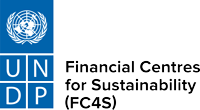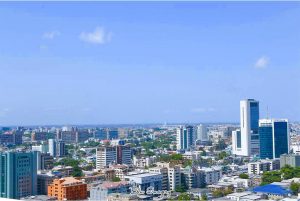Case Studies
A survey for Africa Climate Week in March 2019 showed that most African nations were already starting to implement their mitigation and adaptation commitments under the Paris Agreement. But over...
Established by UAE Federal Decree, Abu Dhabi Global Market (ADGM) includes three independent authorities - the Registration Authority (RA), the Financial Services Regulatory Authority (FSRA) and ADGM Courts. As a...
With 8 members in Asia, in 2019 the FC4S Asia node successfully focused on supporting the establishment of the Real Economy Lab. Launched in October 2019 during the FC4S AGM,...
FC4S Goals
Goal 1
Through its members FC4S will work towards achieving the Paris Agreement and the SDGs.
Goal 2
The FC4S Network will strengthen its role as a primary forum for public-private collaboration on sustainable finance, supporting coherence across markets in response to policy and regulatory developments within member jurisdictions.
Goal 3
All FC4S Centres will advance at least one level on the FC4S Sustainability Alignment Scale by end 2021, as evaluated by the Secretariat on the basis of shared criteria agreed by FC4S members.
Goal 4
The FC4S Network will make a material difference to sustainable finance on the ground in its member financial centre jurisdictions
Sustainability Alignment Scale
Little or no awareness or activity
Center is aware of the need for sustainable finance with early stage, fragmented activities
Started to develop expertise in some areas, action at commitment level, results qualitative
Strategic framework for sustainable finance, some quantitative evidence of financial activity
Sustainable finance material share of assets & transactions, factor of competitiveness
Centre aligned with Paris Agreement and the Sustainable Development Goals
10 Dimensions of Sustainable Financial
PUBLIC FINANCE
1. BANKING:
Major banks
headquartered and
operating in the centre are
engaging in green and
sustainable finance
across their lending book
and capital markets
activities.
2. DEBT CAPITAL MARKETS:
Financial centres are issuing,
underwriting and investing in
green bonds - and credit
rating agencies are factoring
in environmental risks.
3. EQUITY CAPITAL MARKETS:
Stock exchanges, market
participants and securities
regulators in the centre are
integrating sustainability
factors and advancing
environmental solutions.
4. INSURANCE:
Providers and regulators
are increasingly analysing
the relationship between
insurance and climate
change, and providing new
insurance products for the
green economy.
5. INVESTMENT:
Asset owners and
managers in the centre are
integrating ESG factors
along the value chain and
reallocating capital,
supported by pension and
other regulators.
6. SPECIALIST:
Specialized forms of
sustainable and green
finance are flourishing
including carbon markets,
impact investing,
cleantech, green fintech
and social stock
exchanges.
7. POLICY AND
PUBLIC FINANCE:
National and local
regulations and public
finance institutions are
supporting best practice
and crowding in private
capital.
8. LOCAL GREEN INITIATIVES :
Efforts are under way by city
and regional authorities to
mobilize finance for local green
initiatives such as
energy-efficient retrofits, waste
management and resource
efficiency vehicle
infrastructure and mass
transit expansion.
9. MARKET INTERMEDIARIES:
Analysts, legal, accounting
and financial data
providers as well as
professional bodies in the
financial centre are
providing sustainability
expertise to
their clients.
10. KNOWLEDGE:
Universities, NGO's,
consultancies and
coalitions are providing
the insight and impetus to
leadership by the financial
centre on sustainability.
1. BANKING:
Major banks
headquartered and
operating in the centre are
engaging in green and
sustainable finance
across their lending book
and capital markets
activities.
2. DEBT CAPITAL MARKETS:
Financial centres are issuing,
underwriting and investing in
green bonds - and credit
rating agencies are factoring
in environmental risks.
3. EQUITY CAPITAL MARKETS:
Stock exchanges, market
participants and securities
regulators in the centre are
integrating sustainability
factors and advancing
environmental solutions.
4. INSURANCE:
Providers and regulators
are increasingly analysing
the relationship between
insurance and climate
change, and providing new
insurance products for the
green economy.
5. INVESTMENT:
Asset owners and
managers in the centre are
integrating ESG factors
along the value chain and
reallocating capital,
supported by pension and
other regulators.
6. SPECIALIST:
Specialized forms of
sustainable and green
finance are flourishing
including carbon markets,
impact investing,
cleantech, green fintech
and social stock
exchanges.
PUBLIC FINANCE
7. POLICY AND
PUBLIC FINANCE:
National and local
regulations and public
finance institutions are
supporting best practice
and crowding in private
capital.
8. LOCAL GREEN INITIATIVES :
Efforts are under way by city
and regional authorities to
mobilize finance for local green
initiatives such as
energy-efficient retrofits, waste
management and resource
efficiency vehicle
infrastructure and mass
transit expansion.
9. MARKET INTERMEDIARIES:
Analysts, legal, accounting
and financial data
providers as well as
professional bodies in the
financial centre are
providing sustainability
expertise to
their clients.
10. KNOWLEDGE:
Universities, NGO's,
consultancies and
coalitions are providing
the insight and impetus to
leadership by the financial
centre on sustainability.
How FC4S Engages with Members
1
Strengthening Strategic Commitment: stimulating strategic action by financial centres through guidance, assessment tools and data systems.
2
Boosting Market Integrity: bringing clarity and convergence on key definitions, taxonomies and classifications, as well as endorsing international standards.
3
Building Capacity: strengthening the capacity of developing country financial centres, supporting implementation, and strengthening the skills base of financial practitioners.
4
Fostering Innovation: pooling experience on critical issues, such as how to leverage fintech and digital solutions for sustainable finance markets.
5
Serving the Real Economy: exploring models to connect financial centres with real economy needs, such as Green Finance Zones.
The 6-step Process to Support Financial Center's Sustainable Finance Ambitions
Iterative process to improve financial centre performance
1
Assess Position
2
Set Priorities
3
Build Capacity
4
Catalyse Action
5
Promotion
6
Review And Refine
Events / Meetings
20 June 2024, Online














































